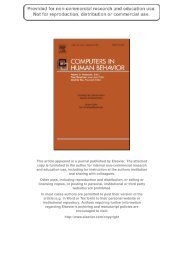Varnhagen.pdf
Create successful ePaper yourself
Turn your PDF publications into a flip-book with our unique Google optimized e-Paper software.
722 C. K. <strong>Varnhagen</strong> et al.<br />
Our second goal was to examine the relationships between spelling ability and new<br />
language use.<br />
Developing a taxonomy of ‘‘new language’’ use in instant messaging is important<br />
for understanding this different communication medium, observing its evolution<br />
over time, and comparing instant messaging with other forms of computer-mediated<br />
communication. To examine our first goal of investigating the use of new language in<br />
online conversations, we selected adolescents as participants because this age group<br />
has grown up with the Internet and is the major user group of instant messaging<br />
(Lenhart et al., 2007; Lenhart et al., 2005; Lenhart et al., 2001). Adolescent<br />
participants collected a history of their instant messaging for a week. We then<br />
administered a standardized spelling test over the same instant messaging program to<br />
measure spelling ability, providing an ecologically valid measure of online spelling<br />
in that the participants typed their spelling in response to digitally recorded words.<br />
We organized use of new language in instant messages into categories<br />
representing short cuts and pragmatic devices and counted apparent typographical<br />
errors and misspellings as shown in Table 1. We began with more general<br />
taxonomies developed by Werry (1996), Driscoll (2002), and Stevenson & Shortis,<br />
(n.d.) to characterize new language use by adults in chat, another type of<br />
synchronous computer-based communication that serves different functions than<br />
instant messaging in the communicative process (Crystal, 2006; Kang & Yang,<br />
2006). These taxonomies included identifying abbreviations, acronyms, letter or<br />
number word substitutions, and emoticons; our taxonomy, as shown in Table 1,<br />
includes these categories as well as additional categories to more completely<br />
categorize new language use in adolescents’ instant messaging. As well, we further<br />
examined the linguistic context in which the new language terms and characters<br />
were used to better understand the function of the different categories.<br />
Given that girls report greater use of instant messaging than boys (Lenhart et al.,<br />
2005), we hypothesized that girls would use more new language and different types<br />
of new language than would boys. Similarly, given that older children report greater<br />
use of instant messaging than younger children (Lenhart et al., 2005; Spears,<br />
Seydegart, & Zulinov, 2005), we hypothesized that new language use would increase<br />
with age.<br />
To address our second goal of relating spelling ability with use of new language, we<br />
examined correlations between spelling ability and overall new language use as well<br />
as different types of new language use. If the new language of instant messaging is<br />
truly a new or a complementary language (e.g., Crystal, 2006; Lewis & Fabos, 2005),<br />
then we might expect both positive and negative transfer between the two ‘‘languages’’<br />
(Figueredo, 2006; Sparks, Patton, Ganschow, Humbach, & Javorsky, 2008) based on<br />
interdependencies between the two languages (Cummins, 1979). Good spellers in<br />
conventional English might make greater use of new language compared with poorer<br />
spellers. On the other hand, in line with parental and media concerns (e.g., Lee, 2002),<br />
we might expect those who use more new language to be poorer spellers.<br />
We recruited adolescents who used instant messaging on a regular basis to<br />
participate. The participants saved their instant messages for a 1-week period and<br />
then we randomly choose a 100 word sample from each adolescent to include in our<br />
corpus. We also administered a standardized spelling test to the participants over<br />
123
















